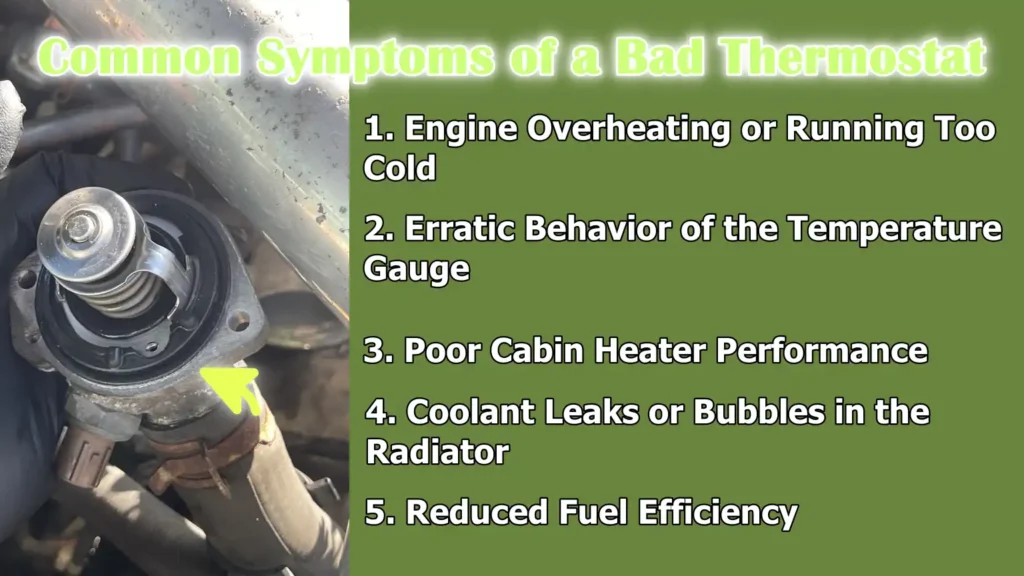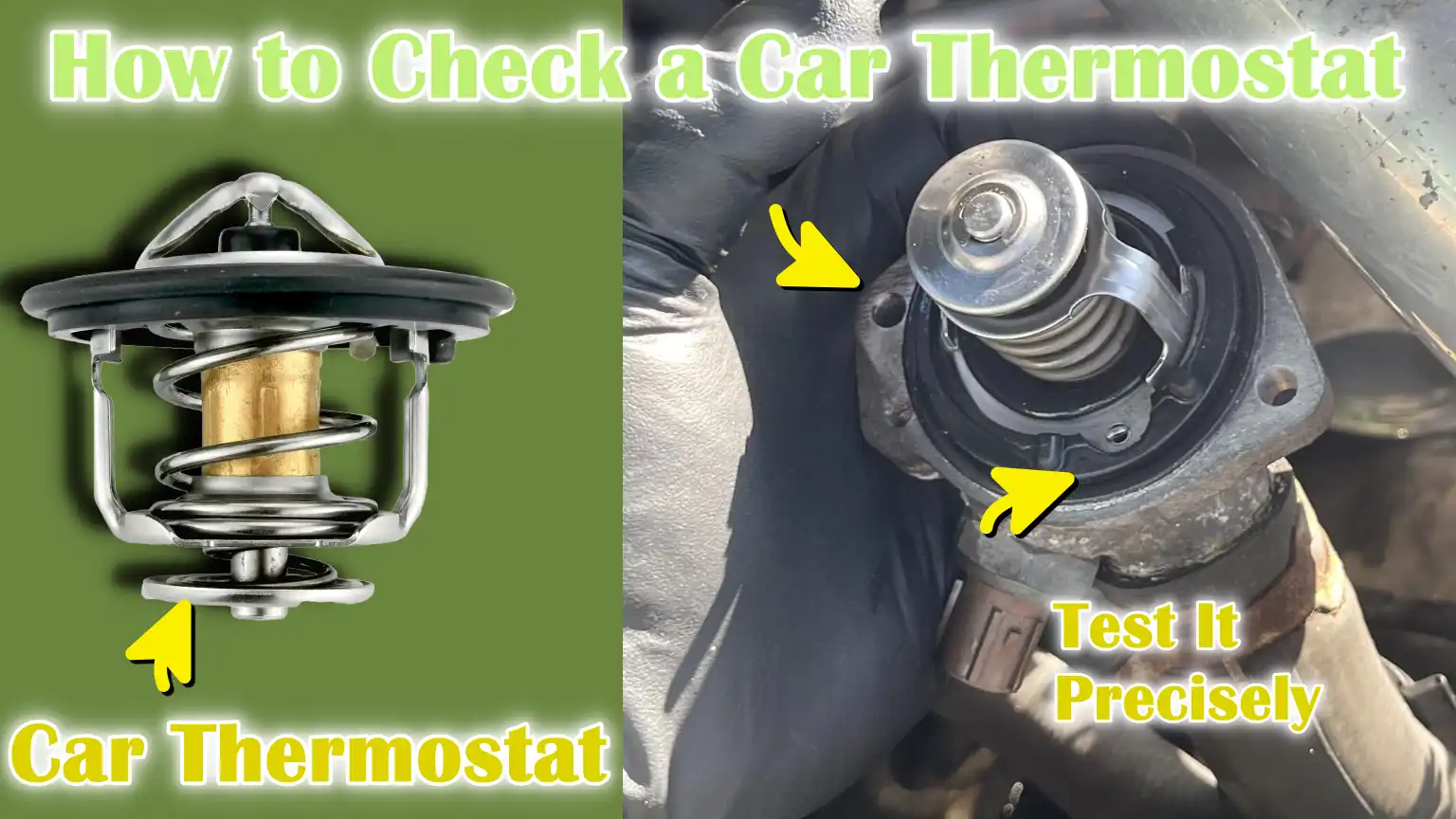Written By: Don Dodi
Fact Checked By: Kristen Brown
Reviewed By: Diego Rosenberg
Basically a car thermostat manages engine temperature, so whenever it fails then temperature can be uncontrollably rise.
Plus, it also acts as a temperature gatekeeper, as it actually controls how coolant flows between the engine and the radiator as to keep the engine operating at the ideal temperature: which is usually between 180°F and 200°F.
When thermostat works in the proper way then it even helps the engine to warm up quickly and then it keeps it from overheating, it improves fuel efficiency, emission in the control way and engine life can be maintained for the longer period of time.
But you should not neglect the health of the thermostat as it gets worn out: then it can lead to some serious issues such as: engine overheating, weak cabin heating or even it can damage the head gasket as well.
So, this guide actually tells you How to Check a Car Thermostat which includes proper understanding about how to detect the problems at early stage and maintain consistent performance.
At First, Understand Everything About the Function of the Thermostat
1. How the Thermostat Controls Coolant Flow
The thermostat in a car acts like a gate that controls the flow of coolant between the engine and the radiator.
When the engine is cold, the thermostat remains closed, preventing coolant circulation.
This allows the engine to warm up quickly and reach its optimum operating temperature.
When the engine reaches the correct temperature, the thermostat opens, allowing coolant to flow into the radiator, where it is cooled before returning to the engine.
This process ensures that the engine temperature remains stable, preventing overheating or overcooling, which can reduce engine performance and increase engine wear.
2. Operating Temperature Range
Most car thermostats are designed to operate within a temperature range of approximately 180°F to 200°F, which is approximately 82°C to 93°C.
This temperature range is chosen to quickly reach the engine’s ideal operating condition while preventing overheating.
A thermostat that opens too early or too late can lead to fuel inefficiency, increased emissions and even engine damage over time.
The exact temperature specifications may vary slightly depending on the make and model of the vehicle, but are usually clearly stated by the manufacturer.
3. How the Thermostat Interacts with the Radiator and Engine Block
The thermostat is located between the engine block and radiator, acting as a vital link in the cooling system.
When closed, coolant remains inside the engine block and cylinder head, absorbing heat and warming the engine.
When it opens, the hot coolant flows into the radiator, where it releases heat to the surrounding air before returning to the engine.
This action is essential because it maintains a balance: the engine remains hot enough for efficient combustion, but not so hot that there is a risk of damaging internal components such as gaskets, pistons, or valves.
4. Explanation of “Open” and “Closed” Positions
The thermostat has two main positions: open and closed.
In the closed position, it blocks the flow of coolant, allowing the engine to warm up quickly.
In the open position, it allows coolant to flow to the radiator, dissipating excess heat.
The transition between these positions is automatic and temperature-dependent.
Some modern thermostats can open gradually instead of all at once, maintaining a stable temperature and reducing engine stress.
A stuck thermostat in either position can cause serious engine problems, so regular inspection and maintenance are essential.
Common Symptoms of a Bad Thermostat

1. Engine Overheating or Running Too Cold
One of the most common symptoms of a bad thermostat is the engine overheating or failing to reach its normal operating temperature.
When the thermostat is stuck in the closed position, coolant cannot reach the radiator, causing the engine to overheat quickly.
Overheating can damage vital components like the head gasket, pistons and cylinder walls.
On the other hand, if the thermostat is stuck open, the engine may take too long to warm up or may never reach the ideal temperature.
This can lead to poor engine performance, increased emissions and increased fuel consumption because the engine is not operating properly.
2. Erratic Behavior of the Temperature Gauge
A bad thermostat often causes the temperature gauge on your dashboard to behave unpredictably.
You may notice sudden fluctuations where the gauge moves into the hot zone or fluctuates between hot and cold readings.
This occurs because the thermostat is not properly controlling coolant flow, resulting in rapid or inconsistent changes in temperature inside the engine.
Erratic gauge behavior is an early warning sign that should not be ignored, as prolonged operation under these conditions can put stress on the engine and cooling system.
3. Poor Cabin Heater Performance
A car’s heating system relies on hot coolant flowing through the heater core.
If the thermostat is stuck open or closed, the engine cannot generate enough heat, resulting in low or irregular cabin heat.
In cold weather, this can make driving uncomfortable and may also indicate that the thermostat is preventing the engine from reaching the proper temperature required for efficient heating and overall engine performance.
4. Coolant Leaks or Bubbles in the Radiator
A bad thermostat can sometimes cause coolant to leak or bubble in the radiator.
When the thermostat fails to open, pressure inside the cooling system can increase because the hot coolant has nowhere to go.
This pressure can push coolant out of the hoses or radiator cap, creating visible leaks or air bubbles in the coolant.
Such leaks reduce the effectiveness of the cooling system and, if not repaired promptly, can cause it to overheat.
5. Reduced Fuel Efficiency
A thermostat malfunction can impact fuel efficiency.
An engine running too cold burns more fuel because it cannot reach optimal operating conditions, while an engine running too hot can cause the vehicle’s computer to reduce power to prevent damage.
Both situations increase fuel consumption and can lead to increased emissions, making it clear that a small component like the thermostat plays a crucial role in a car’s overall efficiency and environmental impact.
Tools
| Tool / Material | Purpose / Use | Additional Notes |
|---|---|---|
| Safety Gloves and Goggles | Protect your hands and eyes when working on the engine and coolant system. | Always wear gloves and goggles, even when the engine is cold. |
| Socket Set or Wrench | Used to remove bolts and loosen the thermostat housing. | Make sure the size matches the bolts on your vehicle. |
| Thermometer or Infrared Temperature Gun | Accurately measures engine temperature or coolant temperature. | This helps confirm whether the thermostat is opening at the correct temperature. |
| Coolant Catch Pan | Collects old coolant when draining the system. | Prevents spills and keeps the workspace clean. |
| New Gasket | Replaces old gasket when removing or reinstalling thermostat. | This ensures that there are no leaks after installation. |
| Clean Water and Coolant Mixture | Used to refill the cooling system after testing or replacement. | Use the correct ratio of coolant and water as recommended by the car manufacturer. |
Make Sure Your Safety Before Inspecting Car’s Thermostat
1. Ensure the Engine is Completely Cool
Before inspecting or removing the thermostat, it is important to ensure that the engine is completely cool.
Opening the cooling system while the engine is hot can release pressurized coolant, which could cause serious burns or injury.
Engines can remain hot for a long time after being turned off, so it is recommended to wait at least 30-60 minutes before driving.
Keeping the engine cool also prevents accidental damage to parts during handling.
2. Work in a Well-Ventilated Area
It is important to inspect the thermostat or work on the cooling system to avoid inhaling harmful coolant fumes.
Some coolants contain ethylene glycol or other chemicals that can be toxic if inhaled in large quantities.
Working outside or in a garage with doors and windows open ensures that fumes can safely dissipate and protect your health.
3. Never open the radiator cap when the engine is hot
The radiator cap is under high pressure when the engine is hot and opening it can cause boiling coolant to spurt out.
This can cause serious burns and injury.
Always allow the engine and radiator to cool completely and if possible, open the cap slowly with a cloth to safely release any remaining pressure.
Careful handling of the radiator cap is one of the simplest and most important safety measures.
4. Use Protective Gloves and Goggles
Protective gloves and goggles are essential to avoid burns, chemical exposure, or accidental cuts when handling engine parts, coolant and tools.
Gloves protect the skin from contact with hot surfaces and toxic liquids, while goggles protect your eyes from splashes.
Using proper protective equipment ensures that even unexpected events like a sudden coolant leak do not cause injury.
How to Check a Car Thermostat – Complete Procedure for Checking Without Removing It
1. Start the Engine and Let It Idle
Start the car engine and let it idle at a safe and steady idle.
This allows the engine to gradually warm up to the point where the thermostat is designed to open.
Avoid running the engine at high speeds during this process, as idling provides a more accurate measurement of temperature changes and ensures safe observation.
2. Observe the Temperature Gauge as the Engine Warms Up
Keep a close eye on the dashboard temperature gauge as the engine warms up.
A properly functioning thermostat will allow the engine to warm up steadily, usually from cold temperatures to normal operating temperature, which is typically between 180°F and 200°F (82°C to 93°C).
Any unusual spikes, rapid changes, or steady readings may indicate a thermostat problem.
3. Touch the upper radiator hose—it should remain cool until the thermostat opens.
Carefully touch the upper radiator hose while the engine is warming up.
It should remain cool initially, as the thermostat is still closed, preventing coolant from flowing into the radiator.
This step helps you ensure that the thermostat is functioning properly in its closed position, allowing the engine to efficiently reach optimal temperature.
4. When the thermostat opens, the hose will suddenly become hot as coolant flows through it.
As soon as the engine reaches the thermostat’s set operating temperature, the thermostat will open, allowing hot coolant to flow from the engine to the radiator.
You should feel a sudden increase in the temperature of the upper radiator hose, indicating that the thermostat is opening correctly.
This change is important because it indicates that the thermostat is regulating the engine temperature as expected.
5. Use an infrared thermometer to check temperature accuracy
For a more accurate check, use an infrared thermometer to measure the temperature of the upper radiator hose or the engine surface.
This helps ensure that the thermostat opens at the correct temperature, typically around 180-200°F.
Accurate verification ensures that the cooling system is operating efficiently and can prevent overheating, reduced fuel efficiency, or engine damage caused by a faulty thermostat.
How to Inspect the Thermostat After Removing It
1. Drain the Coolant into a Pan
Before removing the thermostat, drain the engine coolant into a clean pan.
This prevents leaks and keeps the workspace safe and clean.
Draining the coolant also relieves pressure in the system, which is important to prevent burns or accidental spills when handling engine parts.
If the coolant is still clean, save it, or if it is old or contaminated, dispose of it according to local regulations.
2. Carefully Remove the Thermostat Housing
Locate the thermostat housing, which connects the upper radiator hose to the engine block and carefully remove it using the appropriate socket or wrench.
Be careful not to damage the housing or surrounding parts.
Removing the housing exposes the thermostat for inspection and is a crucial step in performing a direct inspection.
3. Remove the thermostat and check for corrosion or stuck valves.
After removing the housing, carefully remove the thermostat and inspect it closely.
Look for signs of rust, corrosion, or mineral deposits, which can interfere with proper operation.
Also, check that the valve is not stuck open or closed.
A damaged or rusted thermostat cannot properly regulate engine temperature, which can lead to engine overheating or reduced performance.
4. Place the thermostat in a pot of water and heat it slowly.
To check the thermostat’s functionality, place it in a small pot of water and heat it slowly on the stove or other heat source.
Monitor it with a thermometer as the water temperature rises.
Slow heating ensures you can accurately observe the thermostat’s response without damaging it.
5. Note its opening—compare it to the temperature rating provided by the manufacturer.
Watch the thermostat closely as the water heats.
It should begin to open at the temperature specified by the vehicle manufacturer, usually between 180°F and 200°F (82°C to 93°C).
Note the temperature at which it begins to open and compare it to the recommended range.
A thermostat that opens too early or too late can cause engine performance problems, reduced fuel efficiency and increased wear.
6. If it opens too late, too early, or not at all, replace it.
If the thermostat does not open within the correct temperature range or does not open at all, it should be replaced with a new thermostat according to the manufacturer’s instructions.
Reinstall the thermostat with a new gasket, refill the coolant and bleed the air from the system so it works properly.
Replacing a faulty thermostat is an easy step that can prevent major engine damage and help the cooling system function efficiently.
Read More:
Common Testing Mistakes of Car Thermostat that You Should Avoid
1. Checking the Thermostat When the Engine is Warm
One of the most common mistakes is checking or removing the thermostat when the engine is warm.
Hot engines and cooling systems are under pressure and opening the radiator or handling parts in this condition can result in hot coolant, which can cause serious burns.
Always wait until the engine has completely cooled before inspecting or removing the thermostat.
This ensures safety and prevents accidental injury to both the engine and the technician.
2. Not Using a Calibrated Thermometer
Accurate temperature measurement is crucial when testing the thermostat.
Using an uncalibrated or low-quality thermometer can give inaccurate readings, making it difficult to determine whether the thermostat is opening at the correct temperature.
A calibrated thermometer or infrared temperature gun ensures accurate monitoring, helping to confirm that the thermostat is operating according to manufacturer specifications and preventing unnecessary replacement or misdiagnosis.
3. Forgetting to Replace the Old Gasket or Seal During Reinstallation
Another common mistake is reinstalling the thermostat without replacing the old gasket or seal.
Old gaskets can wear out, crack, or become compressed, causing a leak in the cooling system.
Even a small leak can reduce cooling capacity and increase the risk of engine overheating.
Always use a new gasket or seal when reinstalling the thermostat to ensure a proper, leak-free operation and optimal engine performance.
4. Reusing Old Coolant Contaminated with Debris
Reusing old coolant containing dirt, rust, or debris can damage the thermostat and other cooling system components.
Contaminated coolant can clog the thermostat valve, corrode internal parts and reduce overall cooling capacity.
Draining and replacing the coolant with a fresh, well-mixed solution of water and coolant ensures smooth operation and extends the life of the thermostat and engine.
What To Do If Thermostat Fails The Test
1. Replace with the correct OEM or recommended thermostat
If the thermostat does not open or closes too slowly, it should be replaced immediately with a new thermostat that meets the vehicle manufacturer’s specifications.
Using the correct OEM or recommended thermostat ensures proper temperature control, prevents engine overheating and maintains fuel efficiency.
Installing the wrong thermostat can cause coolant flow problems, engine damage and potential warranty issues, so choosing the correct part is crucial.
2. Clean the Housing and Install a New Gasket
Before installing the new thermostat, thoroughly clean the thermostat housing and mating surfaces to remove any old gasket, rust, or debris.
This ensures a proper seal when the new thermostat is installed.
Install a new gasket to prevent leaks, as even a small coolant leak can reduce cooling efficiency and cause the engine to overheat or be damaged.
3. Fill Coolant and Remove Air from the System
After installing the thermostat, refill the cooling system with a clean mixture of coolant and water in the correct ratio recommended by the manufacturer.
Bleeding is also essential to remove trapped air from the system, as this can create hot spots, reduce coolant flow and cause the engine to overheat.
Proper bleeding ensures that coolant circulates efficiently and maintains a stable engine temperature.
4. Recheck Operation After Installation
After installing the thermostat and refilling the system, start the engine and carefully monitor its temperature.
Ensure that the thermostat opens at the correct temperature and that coolant flows smoothly to the radiator and engine block.
Rechecking operation confirms that the new thermostat is functioning properly, preventing engine overheating, improving fuel efficiency and ensuring reliable vehicle operation.
How to Maintain Thermostat With Prevention Tips to Consider
Not only this, there’s a experimental analysis which compares engine operation with and without a thermostat and it found out that using a thermostat actually shortens the warm-up period and that actually reduces fuel consumption, but you need to have perfect kind of thermostat condition otherwise it can also increase the temperature oscillations in the coolant which may raise localised boiling risk in few engine zones.[¹]
1. Replace the thermostat every 50,000-100,000 miles (depending on the vehicle)
Thermostats can deteriorate over time, causing temperature control problems, overheating, or poor engine performance.
Most manufacturers recommend replacing the thermostat between 50,000 and 100,000 miles, depending on the vehicle model and usage conditions.
Timely replacement helps prevent unexpected malfunctions, maintain stable engine temperatures and extend the life of the cooling system.
2. Regularly Check Coolant Condition and Level
Maintaining proper coolant levels and monitoring their condition is essential for a healthy cooling system.
Low coolant or poor fluid can reduce heat transfer, cause the engine to overheat and damage the thermostat.
Regular checks ensure that the engine receives adequate cooling and that the thermostat operates properly within its intended temperature range.
3. Inspect hoses and radiator for leaks or blockages
Hoses and radiators are critical parts of the cooling system.
Regular inspections help identify cracks, leaks, or blockages that can obstruct coolant flow and put excess pressure on the thermostat.
Addressing these problems promptly prevents overheating, ensures efficient heat transfer and reduces the likelihood of costly repairs that could damage the thermostat or engine.
4. Flush the cooling system periodically
Over time, rust, dirt and other debris can accumulate in the cooling system, impairing thermostat operation and reducing cooling efficiency.
Periodically flushing the cooling system removes these contaminants, restores coolant flow and ensures that the thermostat and other components continue to function optimally.
This preventative maintenance step increases engine longevity, fuel efficiency and overall vehicle reliability.
Conclusion – How to Check a Car Thermostat
Actually, it is 100% true that engines just can’t thrive without a proper temperature control and that what well-maintained thermostat does by balancing performance & fuel efficiency.
A properly functioning thermostat ensures the engine warms up quickly, maintains optimal temperature, prevents overheating and improves fuel efficiency.
Ignoring thermostat problems can lead to serious engine issues, including head gasket failure, poor combustion and costly repairs.
By regularly inspecting, testing and replacing the thermostat when necessary, as well as monitoring coolant levels, inspecting hoses and flushing the cooling system, drivers can prevent unexpected breakdowns and extend the life of their vehicles.
Understanding how the thermostat works and following safe, accurate testing procedures enables car owners to take control of their vehicle’s performance, save money on repairs and enjoy worry-free driving.
Regular thermostat care isn’t just maintenance—it’s an investment in engine reliability, safety and long-term efficiency.
Now, it is your turn to ask some questions related to this guide in the comment box.
Frequently Asked Questions
Q1. Can a bad thermostat cause an engine to overheat?
Answer: Yes, a bad thermostat is a major cause of engine overheating. If the thermostat is stuck, coolant cannot reach the radiator, trapping heat and causing the engine temperature to rise rapidly. Overheating can damage the engine’s head gasket, pistons and other critical components. Even a slightly faulty thermostat can cause the engine to overheat, leading to reduced engine performance and costly repairs.
Q2. How do I know if my thermostat is open or closed?
Answer: You can usually determine if the thermostat is open by observing the engine’s temperature behavior. If the engine warms up very slowly or never reaches its normal operating temperature, the thermostat may be open. If the engine overheats quickly or the upper radiator hose remains cold for too long, the thermostat may be closed. This can be confirmed by using an infrared thermometer or by touching the radiator hose while the engine is warming up.
Q3. Is it safe to drive with a faulty thermostat?
Answer: Driving with a faulty thermostat is not recommended. A clogged thermostat can quickly overheat, causing engine damage within minutes. A loose thermostat can prevent the engine from reaching the correct temperature, which can reduce fuel efficiency, increase emissions and damage engine components over time. The safest approach is to inspect and replace a faulty thermostat before traveling long distances.
Q4. How often should I replace my thermostat?
Answer: Most vehicle manufacturers recommend replacing the thermostat every 50,000 to 100,000 miles, depending on the car and driving conditions. Even if it appears to be working properly, replacing it during this interval can prevent unexpected malfunctions, maintain proper engine temperature and improve fuel efficiency. Regular maintenance, including checking the coolant condition and hoses, helps extend the life of the thermostat and engine.
Q5. Can I test the thermostat without removing it from the engine?
Answer: Yes, it is possible to test the thermostat without removing it. You can start the engine and let it idle and monitor the temperature gauge as it warms up. The upper radiator hose should remain cold until the thermostat opens at the correct temperature. Once open, the hose will suddenly heat up and coolant will begin flowing into the radiator. Using an infrared thermometer can provide a more accurate reading, confirming that the thermostat is opening at the manufacturer’s recommended temperature.
References:
[1] Experimental Analysis and Evaluation of Thermostat Effects on Engine Cooling System
https://www.researchgate.net/publication/341272078_Experimental_Analysis_and_Evaluation_of_Thermostat_Effects_on_Engine_Cooling_System

Guys, I’m a car audio enthusiast and customization expert and I love clear sound and clean installation. Plus, I have spent years helping people build their dream audio setups. And whenever I’m working on cars, I probably listen to music and thinks about the next big upgrade.

